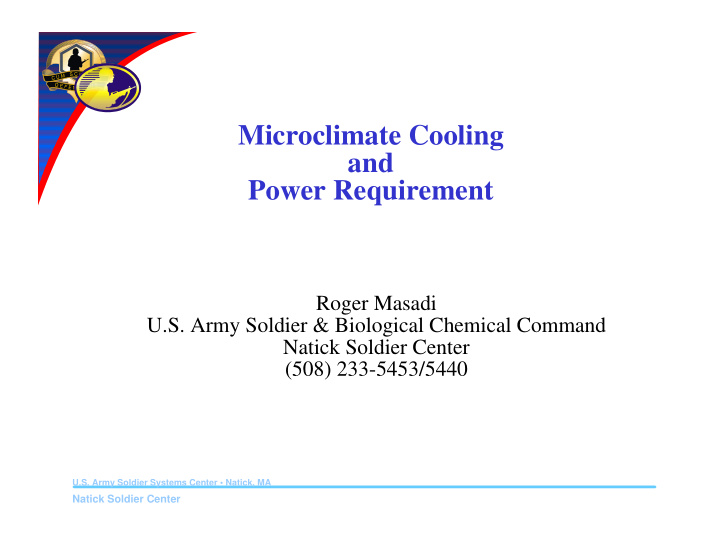



Microclimate Cooling and Power Requirement Roger Masadi U.S. Army Soldier & Biological Chemical Command Natick Soldier Center (508) 233-5453/5440 U.S. Army Soldier Systems Center • Natick, MA Natick Soldier Center
Microclimate Conditioning Thermal Stress Maintaining soldier performance during operations has always been a challenge. High levels of physical activity, clothing and protective gear that prevents heat dissipation from the body, and the carrying of heavy combat equipment are hallmarks military operations. U.S. Army Soldier Systems Center • Natick, MA Natick Soldier Center
Microclimate Conditioning Mission Our goal is to enhance warrior performance in hot and cold environments by reducing heat stress and enhancing protection against cold on the battlefield. One way we’re reducing heat stress on the battlefield is through the development of lightweight, low power microclimate cooling systems. U.S. Army Soldier Systems Center • Natick, MA Natick Soldier Center
Warrior Microclimate Cooling Requirements HOW MUCH COOLING? Depends on: •Ambient Environment Temperature, Humidity, solar load, wind speed, etc •Work Rate Between a low of 100 watts to a high of 500+ watts. •Clothing Ensemble Characteristics Insulation, Vapor Permeability, etc U.S. Army Soldier Systems Center • Natick, MA Natick Soldier Center
Warrior Microclimate Cooling Requirements The dismounted soldier metabolic heat production varies depending on activity levels: •Very Light work rate 100-175 watts (e.g guard duty=137w) •Light work rate 125-325 watts (e.g. cleaning rifle=198w) •Moderate work rate 325-500 watts (e.g. foxhole digging=475w) •Heavy work rate 500+ watts (e.g. emplacement digging=540) U.S. Army Soldier Systems Center • Natick, MA Natick Soldier Center
Warrior Microclimate Cooling Requirements The daily cooling requirement varies between a high of 1200 watt-hours and a low of 600 watt-hours. The cooling rate of 300 watts has been shown to adequately reduce heat stress and enhance performance under a variety of environmental conditions, protective gear, and work rates. Lower cooling rates of 200 and 100 watts have been shown to provide limited heat stress relief in temperate environment. U.S. Army Soldier Systems Center • Natick, MA Natick Soldier Center
Microclimate Cooling Technologies Investigated Foot Pump Wetted Cover Vortex Tube Ambient Air blower Thermoelectric Ice Phase Transition Heat Pipe CO 2 Phase Transition Air-Cycle Endothermic Reaction Heat Pipe Ejector Cooling Solid Absorption Liquid Absorption Stirling Cycle Vapor-Compression U.S. Army Soldier Systems Center • Natick, MA Natick Soldier Center
Microclimate Cooling Recommended Technologies Based on earlier studies these technologies were recommended and pursued: ⇒ Vapor Compression cooling ⇒ Solid Absorption cooling ⇒ Ambient Air blower ⇒ Stirling Cycle cooling ⇒ Ice Phase cooling U.S. Army Soldier Systems Center • Natick, MA Natick Soldier Center
Microclimate Cooling Efforts Recent microclimate cooling efforts: Soldier Integrated Protective Ensemble Air Ventilation System - 1991 Individual Microclimate Cooling System - 1994 Personal Vapor Compression Cooling System - 1996 Personal Ice Cooling System - 1996 Advanced Lightweight Microclimate Cooling System - 1998 Complex Compound Absorption Microclimate Cooling System - 2000 Current microclimate cooling efforts: Air Warrior Microclimate Cooling System - current Army program Advanced Concept Uniform cooling concept - current Army program Integrated Mesoscopic Cooling Circuits-current DARPA program Mesoscopic Adsorption Cooling System -current DARPA program Carbon Absorption Cooling - current DARPA program U.S. Army Soldier Systems Center • Natick, MA Natick Soldier Center
Microclimate Cooling Energy and Power Cooling System Cooling rate/ Continuous/ Minimum Daily Electrical power Intermittent Cooling Energy/ (watts) Duration Electrical Energy (hours) (watt-hours) 300W MCC 300/150 2/12 600/300 200W MCC 200/100 3/12 600/300 100W MCC 100/50 6/12 600/300 Future 100W 100/30 6/12 600/300 MCC U.S. Army Soldier Systems Center • Natick, MA Natick Soldier Center
Ambient Blowers Energy and Power Cooling System Electrical Power Continuous/ Electrical Energy (watts) Intermittent watt-hours Duration (hours) 15 CFM AB 25 6/12 150 13 CFM AB 15 6/12 90 8 CFM AB 7 10/12 70 U.S. Army Soldier Systems Center • Natick, MA Natick Soldier Center
Prototype Air Blowers These efficient brushless DC air blowers are potential candidates for the Objective Force Warrior. They provide high flow rates at low weight and power. These blowers were demonstrated on the Predator concept. Blower Options: •24-volt / 15 CFM air flow @ 3 inch WG Power: 15 watts Weight: 2 Lbs. •12-volt / 13 CFM @ 3 inch WG Power: 15 watts Weight: 2 Lbs. • 6-volt / 8 CFM @ 3 inch WG Power: 7 watts Weight: 2 Lbs. U.S. Army Soldier Systems Center • Natick, MA Natick Soldier Center
Recommend
More recommend